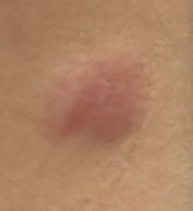
September 2023 Clinical Case of the Month
Title: Allogeneic Stem Cell Transplantation in an atypical presentation of ATLL
Submitted by: Laine Fiscina, MD and Michelle Jacinto, MD, BMT Unit Hospital Sao Rafael, Salvador, Brasil
Physicians expert perspective:
Marco Salvino PhD, Professor of Hematology-Universidade Federal da Bahia, IDOR-BA-HSR, Salvador, Brasil
Maria Dias, MD, Universidade Federal da Bahia/AMO, Salvador, Brasil
A 36-year-old Brazilian woman presented to the pneumologist in December 2022 with a chronic cough lasting for six months after an acute respiratory illness with no etiology defined. She had also noted skin lesions (erythematous nodules) appearing in the last month before the first consultation. The medical previous history was unremarkable, except for HTLV 1 infection discovered during her first pregnancy in 2017.
She had no history of fever, weight loss, night sweats or any peripheral lymphadenopathy. The skin biopsy was compatible with Adult T-cell leukemia/lymphoma (ATLL).


She was then referred to a hematologist. No laboratory abnormalities were noted with normal blood counts, lactate dehydrogenase levels, albumin and calcium. The physical exam was normal, except for the skin lesions. The flow cytometry showed a cluster of in 7,67% malignant lymphocytes (CD2++, CD7++(80%), CD4++, CD5+/++, memCD3+, CD25+, CD45++, CD38+(31%) e CD27+).
Chest CT showed serious infiltration and diffuse ground-glass opacity in the bilateral lung fields. The lung biopsy was compatible with infection by Pneumocystits jiirovecii.
Treated with sulfamethoxazole+trimethoprim and corticosteroids. Right after the treatment, she evolved with acute visual loss. Ophthalmological investigation identified angiitis, retinitis and bilateral anterior and posterior uveitis (frosted branch angiitis) with the polymerase chain reaction (PCR) for HTLV-1 provirus positive in the aqueous humor, without identification of other infections by other pathogens. Corticosteroids were started for the uveitis/angiitis, with subsequent resolution.
1. Which of the following is the most appropriate classification for this ATLL presentation?
A. Smoldering
B. Chronic
C. PTC
D. Lymphomatous
E. Acute
We started ATLL therapy with zidovudine and pegylated interferon to the corticosteroids and the uveitis/angiitis and skin lesions gradually resolved. She did four cycles, presenting anemia with transfusional need which resolved after zidovudine reduction to 300mg and erythropoiesis-stimulating agent (epoetin-alfa).
She underwent an allogeneic HSCT from an HLA-matched sibling (HTLV negative) using mobilized PBSC graft. Conditioning regimen was fludarabine (30mg/m2 x5 doses) and melphalan (140mg/m2 x1 dose). Her GVHD prophylaxis was cyclosporine e methotrexate. Neutrophil and platelet engrafted on day +16 and day +20 respectively.
As post-transplantation complications she presented grade 2 mucositis, subsegmental pulmonary thromboembolism and febrile neutropenia without hemodynamic instability. Currently, 3 months after BMT, she continues to use cyclosporine, without signs of GVHD and infectious complications, with complete chimerism, immunophenotyping of peripheral blood without clonal lymphocytes and without skin lesions, configuring a complete response, and HLTV PCR negative ( previous to transplant it was positive).
2. Which of the following is the most appropriate treatment?
- watch and wait
- Chemotherapy
- IFN+AZT
- IFN+AZT followed by Allogeneic
- Chemotherapy +-Interferon+ AZT
Comments
Adult T-cell leukemia/lymphoma (ATLL) is a mature T cell malignancy associated with a retrovirus designated human T-cell leukemia virus type 1 or human T-cell lymphotropic virus type 1 (HTLV-1) (1).
ATLL was first described in 1977 in Japan, when Uchiyama and colleagues presented the first large case series of patients and speculated that oncogenic viral infection might play a role in its pathogenesis (2,3). The linkage between HTLV-I with ATLL was described later by other authors (4,5,6).
Since then, a diversity in clinical features of the disease was reported, resulting in a division of ATLL into several clinical subtypes with different survival times (3,7,8).
Classically, ATLL has been classified following the clinical forms defined by Shimoyama in 1991 into four clinical types: acute, chronic, lymphoma, and smoldering (7). The acute and lymphoma forms are considered aggressive diseases, while smoldering and chronic forms are considered indolent.
In 2007, Bittencourt et al. suggested including another form of ATLL in Shimoyama’s classification: the primary cutaneous tumoral (PCT) (9). The PCT form was included in the “Revised Adult T-Cell Leukemia-Lymphoma International Consensus Meeting Report '' that was published in 2018 and nowadays guides our clinical management of these patients (3).
Our patient had the diagnosis of HTLV 1 infection in 2017 during her pregnancy and evolved with skin lesions in December 2022. The biopsy was compatible with ATLL and the flow cytometry showed 7,67% malignant T lymphocytes. She had no abnormalities in the laboratory and no other organs involved at the diagnosis. Besides of that she presented with a severe Pneumocystis pneumonia due to immune deficiency and after that a frosted branch angiitis related to HTLV 1.
By the Shimoyamma criteria she could be classified as Smoldering, but because of the skin involvement, in pathology described as a profound infiltration of atypical lymphocytes in the dermis and epidermis and the clinical presentation, we classified this patient with PCT form.(7-9).
Correct Answer to Question 1 – C
ATLL is a complex, rare, and serious disease in part of the most cases. With the exception of the very indolent forms in an elderly patient, where the less invasive approaches may be the wisest, in all other scenarios this should be at least considered. In acute and lymphomamatous forms, Allo Transplant should be performed as quickly as possible (after induction), as we are talking about a very few months of PFS and OS (8,9).
The difficulty in this case was understanding and classifying this presentation, and then making the best clinical decision. The patient clinically had a predominantly cutaneous presentation associated with a neoplastic cell count in the blood. LDH and Calcio were normal. At the time of diagnosis, the patient presented with a severe atypical pulmonary infection (classically associated with ATLL). She then presented with uveitis/angiitis, which we consider a para-neoplastic event (despite it could be part of the symptoms of the patient with the HTLV virus, regardless having ATLL). (10)
The cutaneous presentation (PTC) of ATLL is perhaps one of the less studied. Literature is scarce on the subject, however from what we know, we understand that this presentation follows an evolution and intermediate prognosis between chronic forms and acute forms, with, for example, OS of around 20 months for PTC, comparing to OS of 5 months and 109 months, for acute and smoldering presentations, respectively. (9)
In this case, we had two facilitators in making the decision. First, the patient had one sister, who fortunately was 100% compatible and HLTV negative. Associated with this, she had two serious related clinical presentations of immunodysregulation that supported us in the therapeutic decision (severe pneumocystosis and severe uveitis/angiitis).
Although transplantation is curative in approximately half of patients, it intrinsically presents its associated risks, as well as an inability to control the disease in the aggressive cases without a pre-transplant response, with a high incidence of relapses in these settings. The literature suggests that patients who undergo Allo-BMT with the best response will have better results. The Allo-BMT for non-responders is questionable. The patient fortunately presented an excellent clinical response, with the disappearance of all pre-BMT skin lesions with the IFN and AZT regimen. We chose this immunotherapy as an induction treatment because it has generally lower toxicity than polychemotherapy. The evidence of the use of polychemotherapy associated or not with immunotherapy is greater in the lymphomatous or aggressive presentations. We do not have in Brazil available for ATLL drugs such as Mogamulizumab.(7-9).
Correct Answer to Question 2 – D
References:
1. Allagio R et al. The 5th edition of the World Health Organization Classification of Haematolymphoid Tumours: Lymphoid Neoplasms. Leukemia 36, 1703–1719 (2022).
2. Uchiyama T et al. Adult T-cell leukemia: clinical and hematologic features of 16 cases. Blood 5, 481-492 (1977).
3. Cook LB et al. Revised Adult T-Cell Leukemia-Lymphoma International Consensus Meeting Report. J Clin Oncol 37,1-12 (2018).
4. Poiesz BJ et al. Detection and isolation of type C retrovirus particles from fresh and cultured lymphocytes of a patient with cutaneous T-cell lymphoma. Proc. Natl. Acad. Sci. USA. (1980).
5. Hinuma Y et al. Adult T-cell leukemia: antigen in an ATL cell line and detection of antibodies to the antigen in human sera. Proc. Natl. Acad. Sci. USA 78, 6476–6480 (1981).
6. Yoshida M et al. Isolation and characterization of retrovirus from cell lines of human adult T-cell leukemia and its implication in the disease. Proc. Natl. Acad. Sci. USA 79, 2031–2035 (1982).
7. Shimoyama M et al. Diagnostic criteria and classification of clinical subtypes of adult T-cell leukaemia-lymphoma. British Journal ojHaernatology 79, 428-437 (1991).
8. Kunihiro T et al. Definition, Prognostic Factors, Treatment, and Response Criteria of Adult T-Cell Leukemia-Lymphoma: A Proposal From an International Consensus Meeting. J Clin Oncol 27,453-459 (2019).
9. The importance of the clinical classification of adult T-cell leukemia/lymphoma (ATLL) in the prognosis. Pedro Dantas Oliveira1,2, Guilherme Sousa Ribeiro3,4, Rosangela Oliveira Anjos3, Maria Almeida Dias, Lourdes Farre, Iguaracyra Araujo, Achilea Lisboa Bittencour. PLOS Neglected Tropical Diseases | https://doi.org/10.1371/journal.pntd.0010807 October 19, 2022
10.Prevalence and characteristics of HTLV-associated uveitis in patients from Bahia, an endemic area for HTLV - 1 in Brazil. Piai Ozores D, Rathsam Pinheiro R, Boa-Sorte N, Campos E Silva Dias M, Silva Lima R, Hialla Almeida Araújo T, Galvão-Castro B, Grassi MFR. Virol J. 2023 Aug 21;20(1):185. doi: 10.1186/s12985-023-02135-7.
Future Clinical Case of the Month
If you have a suggestion for future clinical case to feature, please contact Anna Sureda.